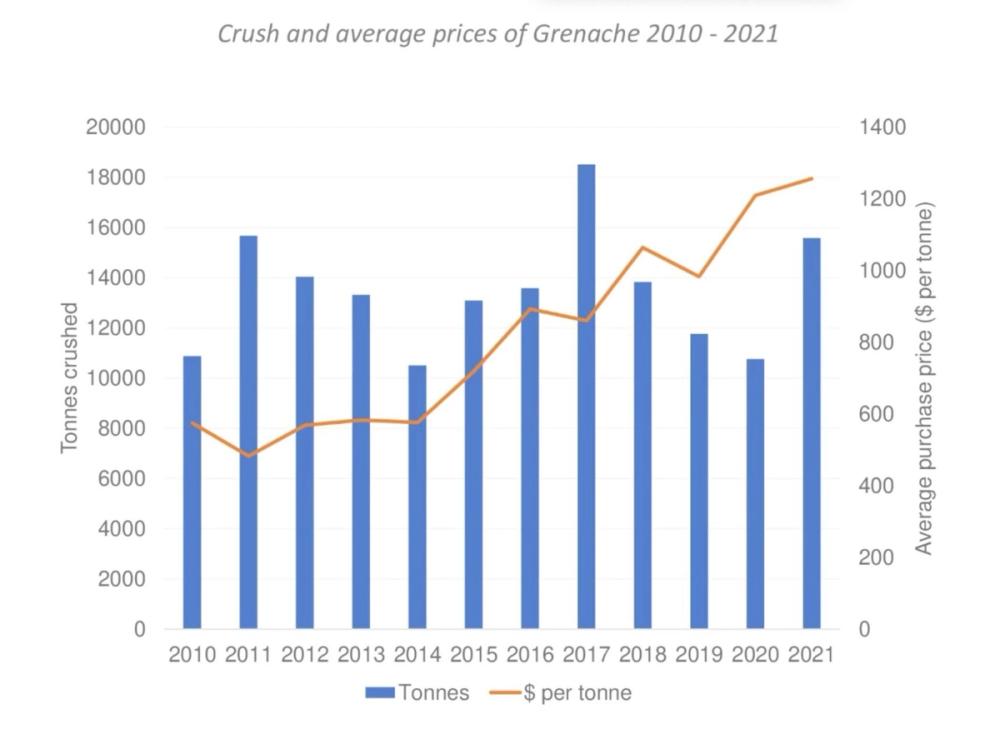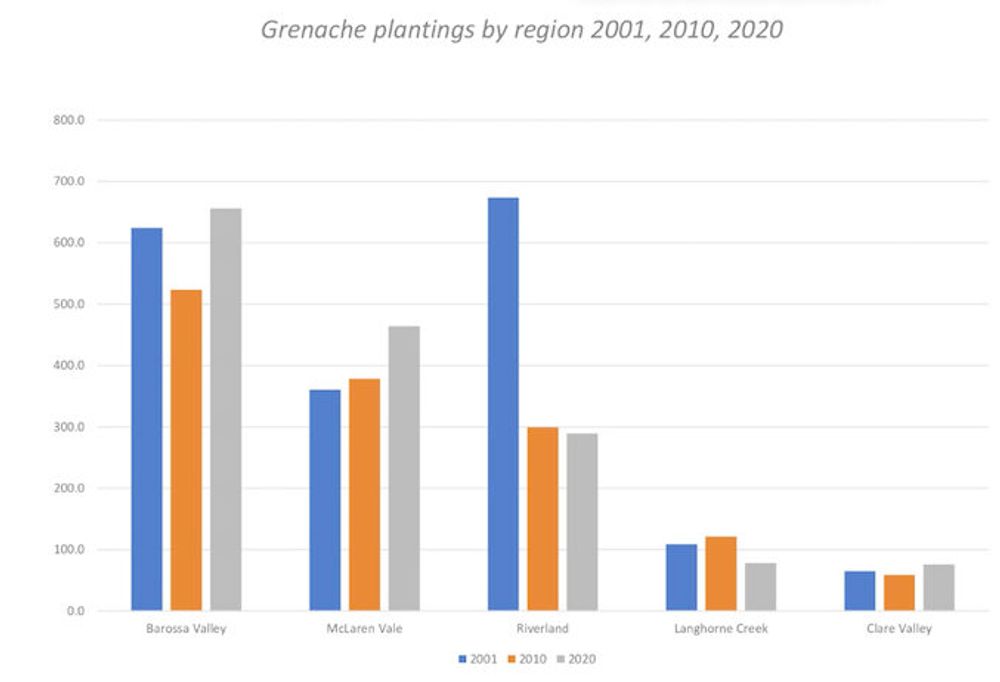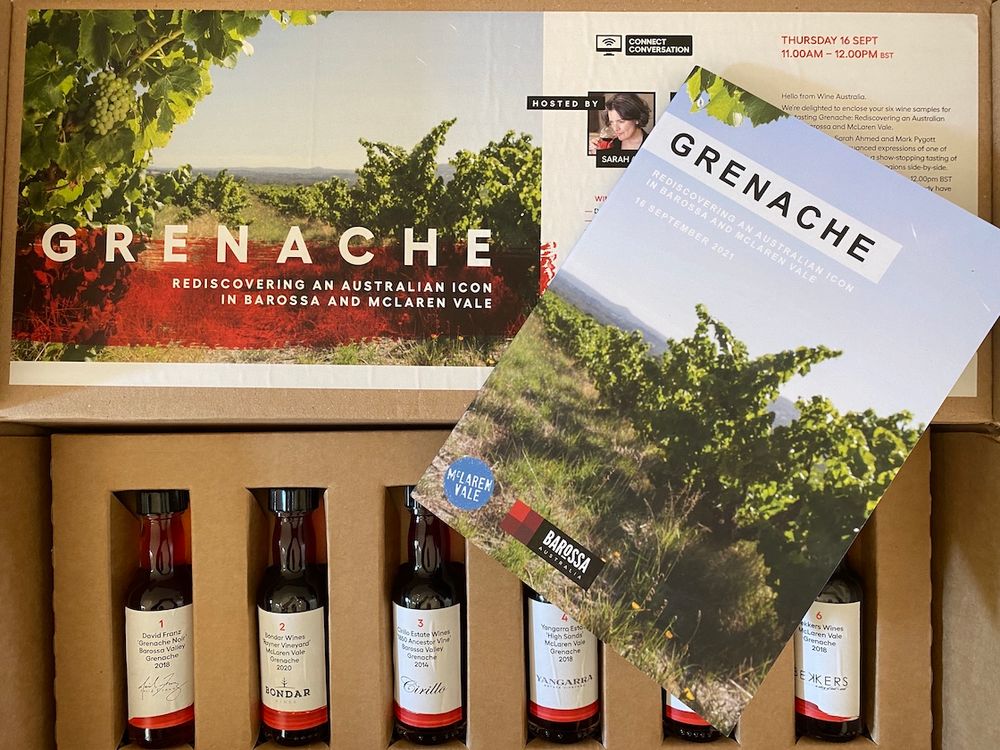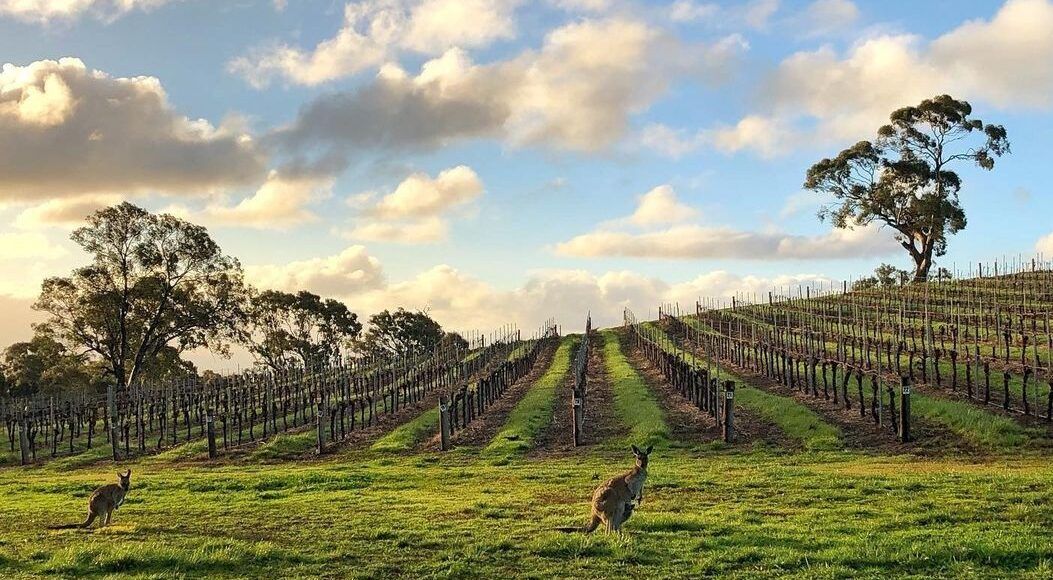Mark Pygott MW argues Aussie Grenache can show as many different styles as Shiraz, especially now that increasing numbers of winemakers are turning their attention to it. “The future is bright for this variety” he says.
As real life tastings resume, Wine Australia’s excellent virtual Connect tastings continue, with attendees connecting from around the world to hear experts opine on the country’s key varieties and regions.

Online presentation as it should be: Mark Pygott MW and Sarah Ahmed representing Barossa and McLaren Vale respectively
This month’s session was “Rediscovering an Australian icon in Barossa and McLaren Vale” a bit of a misnomer because the grape wasn’t Shiraz/Syrah. Instead it was Grenache, the Spanish variety first planted Down Under in the mid-nineteenth century, becoming the most common grape in the fortified wine era of the 1950s through to the 1970s, when frankly, despite some fabulous old vine plantings, it wasn’t treated with much respect. Unsurprisingly then, much of it was grubbed up in the industry’s rush to French varieties in the late twentieth century, and today, despite being present in 50 regions, now represents just 1% of Australian grape crush and most of that from South Australia.
Yet as Mark Pygott MW and Sarah Ahmed argue, this rollercoaster ride in fortunes continues as Grenache now undergoes a transformation from zero to hero; most producers who would have focused on blending it with other varieties or using it as a workhorse, have shifted towards premiumisation, making varietal wines with “verve, drive and length.”
“The current success of high quality Grenache comes on the back of the high demand for Pinot Noir,” says Ahmed, pointing out that prices and crush are now on a steep-rising trend.

Pygott echoes this suggesting Grenache is something of a shape-shifting variety, capable of making light and zesty but also full bodied wines with considerable heft.
“The variety is today being elevated to acknowledge its potential. It’s inherent fruitiness makes for refreshing wines but it is also capable of structure and can age very well if that is the intention of the winemaker,” says Pygott.
Wine Australia’s online Grenache masterclass last year showed 12 very different and very impressive Grenache wines from around the country. This time around we were shown six, three from Barossa specialist Pygott and three from McLaren Vale expert Ahmed, with wine style broken into three: ‘Bright and Crunchy’, ‘Old and Knarly’ and ‘Dark and Moody’.

So which wines and regions shone?
In the ‘Bright and Crunchy’ corner we had David Franz’s Grenache Noir 2018 from the Barossa facing off against Bondar Wines’ Raynar Vineyard Grenache 2020 from McLaren Vale. The former, made from 100 year old vines – not unusual in Barossa, which has some of the oldest vine-stock in Australia – showed softness and low tannin, a very modern and pretty wine that belied its 13.8% alcohol. The latter, made in a famous vineyard once used by Wirra Wirra, was a tad heftier, more savoury and saline. The winner for me? Franz’s moreish, almost pretty Grenache Noir 2018 (Graft Wine).
‘Old and Gnarly’ was a tougher contest because frankly both the wines – Cirillo Estate’s 1850 Ancestor Vine Grenache 2014 (GB Wine Shippers) from Barossa and Yangarra Estate Vineyard’s High Sands Grenache 2018 (Boutinot) from McLaren Vale – were quite delicious, made from old vines with tiny yields and great intensity. Again though, Barossa had the edge possibly because Cirillo has the oldest continuously-producing old vines in the world (planted in 1848, the year of Revolutions in Europe but Down Under a time settlers were bringing across cuttings from Europe to see how they performed in this strange new world). Pygott said this was like drinking history and I won’t disagree. Winemaker Marco Cirillo is quoted as saying these vines “aren’t good because they’re old, they are old because they’re good…in hotter years managing the heat better than younger vines and in wetter years they plod along at the same pace, producing soft delicate Grenache year in, year out.” Enough said.
So finally ‘Dark and Moody’. Again, two delicious wines and of the same vintage, Turkey Flat Vineyard’s Grenache 2018 from Barossa (Mentzendorff) up against Bekkers McLaren Vale Grenache 2018 (Atlas Fine Wines). Again, both were excellent, the Turkey Flat chunky and full with lots of fruit and tannin, the latter maybe a bit sleeker and mineral. Overall my preference was for the Turkey Flat this time because of price – at £50 RRP the Bekkers costs more than double Turkey Flat’s £23 a bottle. So, a hat-trick for Barossa (sorry Sarah).
Any conclusions?
In comparing Grenache from the two regions, then, can any general conclusions be drawn?
Pygott said one should be wary about emphasising soil differences – both have a diversity of soils in which Grenache is successfully grown. Weather makes some difference with Barossa enjoying a continental climate with huge diurnal temperature differences whilst McLaren Vale, 45 minutes south of Adelaide, has a more maritime climate, which could go some way towards explaining the slightly lighter, more ethereal characteristics of its Grenache. But obviously winemaker approach is key here with Barossa producers keen to maximise benefit from their region’s old vines (and it has many, with 150 hectares over 150 years old, called Ancestor Vines to distinguish them from Centenarian Vines, Survivor Vines (over 70 years old) and Old Vines (over 35).
The good news for consumers is that more of these old vine Grenache wines are coming onto the market. Amongst them is Thorn-Clarke Wine’s Saleyards Road Barossa Grenache 2018 (imported by Fine Wines Direct) a hefty 15.5% wine made from 60 year old vines; lots of cherry and plum on the palate. Well-priced, this will evolve nicely to show its full potential.
Pygott argues that Aussie Grenache can show as many different styles as Shiraz, especially now that increasing numbers of winemakers are turning their attention to it. “The future is bright for this variety” he says.
And a final word on the format

The first class press kit
The future also looks bright for this series of Wine Australia’s online tastings. It’s not like me to gush (ask my wife) but Wine Australia is surpassing itself with these events, hosted by well-informed MWs and wine journalists who present interestingly and succinctly, all within one hour, supported by informative printed materials and well-packaged samples. A real joy.
Next up – Shiraz. I’ve already booked my place.
You can watch Grenache: Rediscovering an Australian icon in Barossa and McLaren Vale by clicking here.
This feature is Part 1 of a two part special focus on Grenache wines. Watch out for Part 2 on Spain’s Garnacha wines.










































